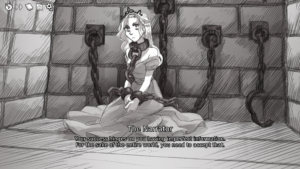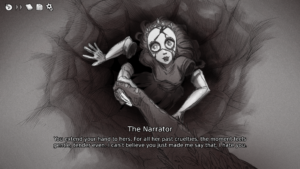Based on its premise alone, I went into Slay the Princess fully expecting it to become one of my all-time favorite games, and I’m thrilled to say it did not disappoint. I’ve always loved games of nuance— games like The Stanley Parable and Galatea which, rather than presenting the player with an expansive world, confine them to a single narrowly defined scenario and then proceed to explore its every nook and crevice. How might the same conversation play out differently if you opened with a greeting or approached without a word? If you delivered a given line with confidence or with a bit of hesitance? If you gave your honest word and later changed your mind or if you knew you were lying from the start? In Slay the Princess, every little detail from your tone of voice to the thoughts you choose to think to how your thoughts and actions align (or misalign) represents a potential fork in the path.

As someone who tends to prioritize exploration in games, often intentionally avoiding forward progression so I can make sure I’ve seen everything there is to see in an area before moving on, this was at times incredibly frustrating for me. I constantly found myself saving and reloading so I could try out multiple options at each branchpoint, but I also got the sense that there was little point to this strategy; after all, it wasn’t each individual choice that mattered, but the accumulation of my choices and the order I made them in, so no matter how many choices I made and re-made to try and explore my options, I was only ever seeing a small subset of the possible permutations. Honestly, it sometimes made me despair to see the lists of options and be so acutely aware of how many versions of the story I wasn’t seeing, of how many playthroughs it would take to get the full picture… but it was a fun, motivating kind of despair.
Something else that struck me about Slay the Princess was how deliberately it plays with the very concept of the “magic circle,” testing its limits and stating its unspoken assumptions out loud as if almost challenging the player to protest. There’s a princess in a cabin and you must slay her; if you don’t, the world will end. What’s that you ask? Who is this princess and who locked her away? How and why would she end the world, and how do you even know that’s going to happen? It doesn’t matter. You’re not owed an explanation, and none need exist; the Narrator said so, and so it is true. To play the game, to enter the magic circle, you have no choice but to accept its premise and play by its rules.

However, a game is also, fundamentally, an object. Its world exists only in the player’s mind, and only their will can change the outcome of its story; through their choices, the player creates themself within the game and creates a version of the game’s world that suits them. Slay the Princess relishes in making this player-game power dynamic viscerally explicit, turning player agency into a vehicle for psychological horror by pushing it to its furthest extreme. Whatever you think, as the player, is true: whatever sort of person you expect the Princess to be, that’s who she is. Whatever sort of person your choices reflect, that’s who you are. Your confidence is always warranted, and your hunches are always correct, and your fears always come true… if you charge ahead blindly, there was never any need for hesitation, but if you hang back and second-guess, you were wise to do so. It forces the player into an unusual mode of decision-making where they must evaluate each option not by asking “Is this the right choice?,” but rather “In what sort of world would this be the right choice?”— knowing that no matter what they choose, the world will reshape itself to make them right.

It’s difficult to fully summarize my feelings about this game, but I have no doubt that its haunting artwork and inventive storytelling style will stick with me and inspire me for a long time to come— and I will certainly be playing through it again!



Fantastic review, Jasmine! Your deep dive into the nuances of *Slay the Princess* is truly insightful. The comparison to games like *The Stanley Parable* and *Galatea* really highlights the intricate decision-making and storytelling mechanics at play. I also found the way the game plays with the “magic circle” concept both intriguing and unsettling, forcing players to question their own perceptions and choices. It’s fascinating how our expectations shape the game’s world and characters. Your reflections on the game’s haunting artwork and its impact resonate with me—it’s a game that leaves a lasting impression. Looking forward to seeing how others experience and interpret its unique narrative!
Hi Jasmine!
I enjoyed reading your thoughts on Slay the Princess. It’s crazy how such a narrowly-defined scenario can offer such depth and variety in storytelling. Hearing about your need to explore the other pathways kinda makes me antsy to know too! Your connection with the magic circle concept was spot-on and something I have never noticed before. The concept of the game reminds me of Inscryption — being forced to move forward to slay the princess vs being forced to sit down and play with the game master. These magic circle games are so interesting to me, and I definitely want to explore this genre further. Also curious about the other nuanced games you mentioned at the beginning! Thanks for sharing such a thoughtful review 🙂
Yeah I entirely agree on the branching/saving part. I think this is game’s way of encouraging you to just let it go. The combinatorial explosion makes it so difficult to “see everything” on a single playthrough, and its outright impossible since the game ends when sufficient aspects of the princess have been unlocked. I convinced myself to let it go, and that I’d simply replay the game at a later point, but I actually found replaying the game itself to be a little bit tedious. The strength is in the narrative/voice acting, and hearing the same lines isn’t all that fun, and with so many minor differences it’s super hard to track them all down or even remember which different options you have to take on a repeat playthrough. I enjoyed the game for what it is but that completionist aspect of me is still loudly yelling in the back of my head.